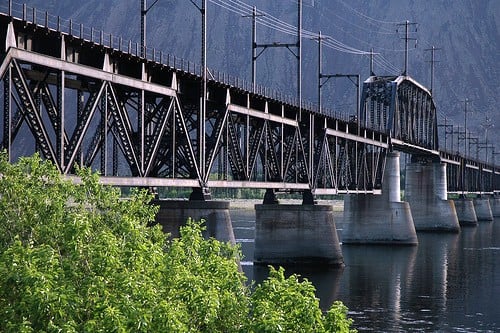Washington state hosts approximately 49 railroads
Class I, II and III, passenger carries and private freight carriers. I was able to list 11 railroad bridges in Washington, out of which, 7 are railroad bridges on the National Register of Historic Places in Washington State.
The railroad industry has an abundant history in Washington State, which can be traced back to 1850’s.
Let’s check out the Railroad Bridges that Washington State has to offer.
Beverly Railroad Bridge was built by The Milwaukee Road in 1909 in the time of the great extension, also called Pacific Extension, which included the transcontinental rail line from Chicago, IL to Tacoma, WA.
As a means of crossing the Columbia River, the bridge was constructed on concrete piers, 85 feet above the water.
The design involved, Warren deck trusses, Parker through truss for the main span, and deck plate girders (approaches).
The bridge had catenary support for over 50 years, as a way to electrify the bridge for the electric locomotives. Once the diesel locomotives took their place, the catenary was removed.
The actual owner, which is the State of Washington, took the ownership in lieu of back taxes owed by the railroad, and they listed the bridge in the National Register of Historic Places in 1982. Unfortunately the bridge is closed due to its poor condition.
Photo credit to Wikipedia.com
Burlington Northern Railroad Bridge 9.6 also known as the Columbia River Railroad Bridge construction was started on February 8, 1906 and it was built to connect Oregon to Washington State right over Columbia River.
The bridge is 2,807 foot long, and pivots on the base to allow the passage of taller ships, being classified as a swing bridge with Pratt truss.
With the first train crossing it on October 23, 1908 the bridge was fully open for business
By November, same year.
Today the bridge carries 2 railroad tracks, used by passenger and freight trains with a daily traffic of 63 freights and 10 AmTrak.
Dungeness River Bridge first bridge was constructed by the Seattle, Port Angeles and Western Railway, a subsidiary of the Milwaukee Road in 1916. The bridge was built of wood and it crossed the Dungeness River.
The second bridge built, replaced the old one in 1930, built as its predecessor, of wood is a through Howe truss 156 feet long and 22 feet high.
Today the bridge is the centerpiece of the Railroad Bridge Park near the town of Sequim. It was added to the National Register of Historic Places in 1982, being one of the last timber Howe through-truss railroad bridges in Washington State.
High Bridge was built by the Burlington Northern Railroad back in 1972. The bridge links the former Northern Pacific mainline with the former Great Northern and Spokane, Portland and Seattle lines to the west, over Latah Creek in Spokane.The bridge is 3,950 feet long, with piers up to 175 feet the the base of the Latah Creek Canyon.
High Steel Bridgeis a truss arch bridge that spans Skokomish River on F.S.R #2202 near the city of Shelton, being in the top twenty highest bridges in the United States. The bridge carried one railroad track, making a huge impact on previously inaccessible timber on the Olympic Peninsula. The bridge total length is 685 feet and was added to the National Register of Historic Places in July 16, 1982.
Celilo Bridge – has been open for traffic in 1912, it spans over Columbia River, it consists of eight steel truss spans and several deck girder spans. In 1957 the bridge was upgraded with a vertical-lift section.
The bridge carries one railroad track which is BNSF Railway and has a total length of approx. 2.400-3.350 feet.
Rock Island Railroad Bridge was the first ever bridge to span the Columbia River, the site was at Rock Island, and it was chosen as a result of being the shortest distance between the banks of the Columbia River in the state. The bridge carries 1 railroad line and it was first opened in 1892.
The Rosalia Railroad Bridge was built by the Milwaukee Road in 1915, with a concrete arch design, being visible from many places, the company decided to employ the unusual material, chasing an impressive-looking bridge. The bridge includes two spans, separated by an embankment. Same as Beverly Railroad Bridge, The Rosalia Railroad Bridge was acquired by the State of Washington in lieu of back taxes owed by the Milwaukee Road; they listed it in the National Register of Historic Places on July 16, 1982, due to its design.
The Salmon Bay Bridge, or Bridge No.4 is a bridge spanning across Salmon Bay, built in 1914 by the Great Northern Railway, connects Magnolia to Ballard in Seattle. It involves a single-leaf bascule system and it carries the main line of the BNSF Railway. The bridge has two tracks and an opening span of 200 feet.
The Vance Creek Bridge was built for a logging railroad in 1929, being the second-highest railroad arch in the United States, right after High Steel Bridge. The bridge was added to the National Register of Historic Places in 1982 and to the Mason County Historic Preservation Register in 2008.
The Wilburton Trestle carries a single track of the BNSF Woodinville Subdivision line, completed in 1904 it measures 102 feet high and 975 feet long, being the longest wooden trestle in the Pacific Northwest.
References: Wikipedia.org Credit
 [/cs_content_seo]
[/cs_content_seo]
